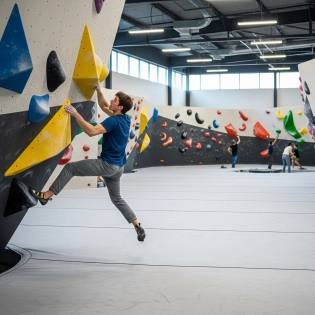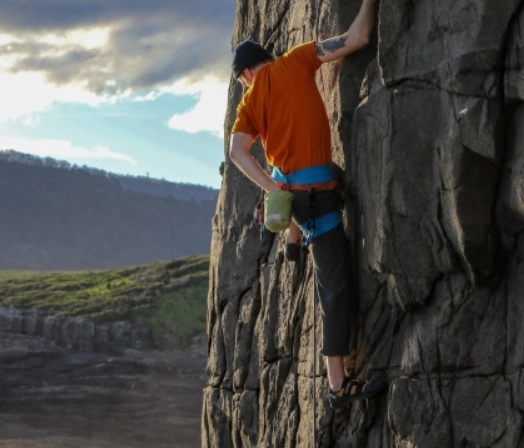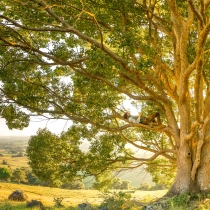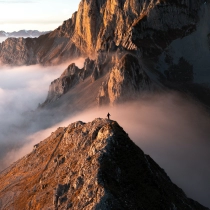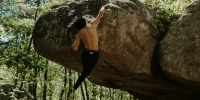
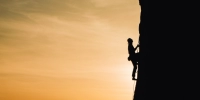
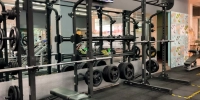
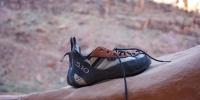




Climbers Point
If you don't have a gym, there are still plenty of exercises that you can do that can make you a stronger climber.
Depending on where you live, your best bet may be to just find a playground, they usually have pull-up bars and other equipment that you can do some body-weight exercises.
You can do pull-ups and all of its many variations. Push-ups and all of its variations. Running, sprinting, or jogging for legs. You can also do squats and calf raises, which are great.
You can also either buy or make a hangboard and a pinch block. These are the two classic climbing exercise equipment. The pinch block would be the easier to make, or the cheaper to buy, it's really just a block of wood with a hole in the middle of it to attach a rope and weights to it. The only issue is that you need weights for this to be effective, or something heavy that you can attach to it, like a heavy rock.
Other than that, if you can get a hangboard, that will be your next best option. Hangboards are used for training your fingers by hanging from them from your fingertips. Be warned though that it is very easy to injure yourself on hangboards, and most suggest only doing it after 1 year of climbing.
I always go for body weight exercises. There are always exercises that you can do to challenge yourself and that you can find hard, like learning to do handstands and doing handstand push-ups.
The real question would be if planks are good for your core.
Your core is very important for climbing as it is used in almost any climbing move, and can really help make you a better climber. It helps stabilize you, it can help keep you closer to the wall, and it can help you move in ways that without core strength would be very, very difficult.
So, core strength is very important for climbing, now the question is if planks are a good core exercise, or if it has little effect on the core.
Based on what can be found online, many people suggest doing planks instead of other exercises such as crunches due to less strain on the spine.
Planks work your back, shoulders, abs, legs and arms, all at the same time, while putting less strain on your spine, which is why many people recommend it.
Whether there are other exercises that are better for core strength than planks is another question, but based on what experts say and on research that can be found online, doing planks is a great exercise for core strength, which should translate to being a great exercise for climbing since climbing requires a strong core.
Because it is both a physical challenge, and also a mental challenge. Yes, many sports include a mental challenge, but climbing specifically requires problem-solving skills.
The sport requires you to understand the routes, to understand your options and how to get to the top. A rock climbing route is essentially a puzzle that you need to solve. Solving it is both a mental and physical challenge. To solve it, you need to understand the route, how it's built and what it requires, and you need to understand what your capabilities and skills are. Then you need to use those understandings to find the best way to reach the top for you.
This is another great part of the sport - there is no one correct way to reach the top.
Every climber can have their own climbing style, some are more powerful, some are more technical, some combine the two. Some prefer crimpy holds, some prefer pinches. Some are flexible, some are not.
Every one of these elements, and more, contribute to the climbing style of the climber, which makes each climber quite unique in the way they climb, and in the way they solve the puzzles (climb the routes).
This means that you may see 10 people reaching the top of a route, and each of them may have done it in a slightly different way, and you yourself may also do it in a different way.
Yes! Bouldering is one of those sports that you really don't need anyone with you to do it, you can sign up to a climbing gym and just start climbing.
It's a very friendly sport, most climbers are very helpful, open and willing to help others and climb with others, if of course that is what you want, if not then you can always just go and climb on your own.
It does help to climb with others, it helps when you have others to bounce ideas of off, or to learn from, but even if you want to go and climb alone as a hobby, a meditative practice, or what ever the reason, you can just go and do it.
If you are asking about outdoor bouldering, then the answer is no, you will need additional people with you to keep you safe and watch over you as you climb. Climbing gyms are different in this aspect as the routes are usually built much safer than the routes you may find outdoors, they are usually also shorter, so even if you fall, you don't fall from very height up. In gyms, you also fall on climbing mats, which are basically mattresses that soften your fall, whereas with outdoor bouldering you will need to bring enough crash pads to cover the area below you, which can add to the risk if not well-prepared.
You do need certain levels of upper and lower body strength, but, the amount of strength really depends on the grade you want to climb.
If you are a beginner, then you don't really need any extra strength to start climbing, as the beginner level routes are very easy. They are similar to climbing ladders, just with some curves.
If you want to climb harder grades, then yes you will need upper body strength, and lower body strength also. Though, by the time you get to these harder routes, you will probably build up that strength anyway through your climbing journey to those grades, and if not, you can include some additional training into your schedule.
Just to point this out though, I have quite a bit of upper body strength as I have been lifting weights for many years on and off, and I climb v7/v8 normally. I have a friend who is significant weaker than me, but, he climbs v8+ and is a much better climber than me. The point is that even if you do not have a lot of upper body strength, you can still be a great climber and climb hard routes. The upper body strength helps, but it's really a combination of strength and technique that will make the biggest difference.
There is no real rule as to how flexible you need to be for climbing, but, being flexible can really help a lot in climbing and in solving the problems. It gives you more tools to use on the wall to finish the routes.
Having basic flexibility and a full range of motion is a good starting point, and building on that can get you a long way in climbing.
If you are not flexible, though, don't think that you won't be able to climb hard routes. I have known many people who cannot touch their toes even with slightly bent knees, and they can climb v7/v8.
On the other hand, I know some climbers who are very flexible and that are relatively beginners, they normally climb v5/v6, but sometimes they are able to top some v7s due to their flexibility. It just gives them that additional advantage.
Being flexible can also help prevent injuries. Some routes require a low level of flexibility, and others may require quite a high level of flexibility. Working on routes that require a level of flexibility that you do not have could result in injury.
Being flexible in general also just helps prevents injuries.
Squats are great for building general leg strength, while also working many other upper body muscles.
Another great exercise is sprinting. Sprinting can really push you to your limits and give you that leg power you are looking for.
Pistol squats is another great exercise that is very popular among climbers. It's very similar to regular squats, but also quite different, as you will need to put extra effort in balancing yourself on one leg in order to do the squat. To make it easier, you can do it while standing on the edge of a box, and performing the squat there. Part of the difficulty in the pistol squat is doing the squat with your other leg extended out front. So, by minimizing the amount that leg must be out front will make the squat easier to perform, and this is done by standing on something tall.
Calf raises are a great exercise and a personal favorite for building and strengthening the calf muscles. It is also one of the easiest exercises that can be performed. All you need is a step, this can be a staircase step, a weight that you stand on, or anything else with an edge that you can stand on and have your heel touch the ground. Just make sure that what ever you are standing is tall enough so that your calf muscle will actually be extended when your heel touches the ground. To do the exercise, stand on the edge with your toes, lower your heel to the ground, and lift yourself up slowly, hold at the top for a second, and then lower yourself slowly, and repeat.
The bottom line is that building leg strength for climbing is just like building leg strength in general, really. In climbing, you use your legs for certain hooks, jumps, dynamic movements, and stabilization, all of which require general leg strength in most or all of your main leg muscles. The exercises above will work those muscles.
It is also important to keep in mind that climbing itself activates certain muscles that may not be activated in other exercises, and they may be used in certain ways and conditions that are hard to replicate outside of climbing. These situations are also important for training and strengthening your muscles, and not just your leg muscles, so keep on climbing, and add the additional leg exercises as a supplement to your climbing.
Indoor bouldering doesn't require a climbing partner, so if you cannot find someone to go with, then that is ok. Bouldering requires extra people when you do it outdoors, since you will need crash pads and spotters to watch over you while you climb. Indoor bouldering, though, does not require more people as the gyms have types of mattresses that you fall on, and the bouldering walls are usually at a max height of 15 feet (around 5 meters), while some are even shorter.
Besides the technical aspect, though, bouldering, and climbing in general, is a very friendly sport, at least from my own experience and that of many others. Climbers are usually very welcoming and helpful, so even if you go and climb alone, you can meet new people that can help you or that you can climb with. It's a great place to meet new people.
If, on the other hand, you want to climb alone and not be bothered, that is of course also an option.
It is worth eating after climbing, but it really depends on the time you spent climbing and at what level of effort you climbed at.
If you spent most of the session sitting or just not climbing, eating right after may not be that important, and you could probably just eat awhile after.
If you feel you spent a lot of energy while climbing and are drained, it may be better to eat after.
It also really depends on your diet. Many people train and climb while fasting, so they would only eat when their next meal is scheduled.
In general, if you are not on any specific diet or regime, you can eat right after or wait a while, it is up to you. If you feel weak, faint, or drained, then you just may want to eat something sooner than later.
Training for climbing does not actually require a gym, you can train for climbing from almost anywhere, including your home.
Keep in mind that you should be extra careful with these exercises to not overdo it, and to not injure yourself.
1. Pull-ups
Pull-ups, as you would imagine, can be very beneficial to your climbing. Try to do pull-ups with body weight. Set a goal, and once you reach that goal, try and add more weights if available. If you do not have additional weights, try different variations of pull-ups, such as a wide grip, narrow grip, hammer grip (palms facing each other), mixed grip (once palm facing out and the other palm facing in), towel pull-ups (more about this below), and anything else that comes to mind.
2. Towel pull-ups
Towel pull-ups are a great way to train your grip and pull-ups at the same time. It also allows you to train the one arm pull-up. To do this, simply take a towel and toss it around a bar. Grab each end of the towel, and start doing pull-ups. Having 2 towels (one per hand) may be more comfortable.
To add the extra challenge of training the one arm pull-up, unbalance the towel by making one side higher and one side lower. This will cause an imbalance in the grip, which will cause one arm to pull harder than the other. Try to lower one arm as much as possible to put more weight on the pulling arm (you can do this with a band also, this will give you more room to lower your hand and to train different positions).
3. Push-ups
Though many people think that chest muscles are not needed for climbing, they actually are needed, and it is important to train them to balance your muscles out to prevent serious muscle imbalances, which could have negative effects such as poor posture.
Push-ups are a very basic and easy exercise to perform, and it's one that can be done almost anywhere. To make the exercise harder, perform different variations of, such as wide hand position, close hand position, one hand higher and one lower, adding weights to your back if available, raising your feet (you can go all the way to a hand stand with this if you are capable).
4. Dips
Another great chest and triceps exercise if you have a set of parallel bars. Just like the other exercises, if you have some weights available (or even a heavy rock or water bottle), try adding them to the exercise for extra difficulty.
5. Squats, calf raises, and sprinting
Just like with chest and triceps muscles, legs are also very important to train in order to prevent imbalances, and legs are in fact used and important in climbing.
Squats are a great way to develop leg strength and mobility. You can do it with body weight, or add additional weights if available, or do different variations of it, such as jumping high when reaching the top of the squat.
Calf raises are great for training the calf muscles, just find an edge, put your toes on it, lower your heel to the ground, and just raise yourself as high as you can from your toes, hold for a second, and lower.
Sprinting is a great all-round leg exercise that really pushes you to your limit and can show a lot of results.
6. Pinch blocks
Forearm strength and grip strength can be trained in many different ways, especially outside the gym. One of the best ways to train them is by using blocks such as a pinch block.
What this is, is simply a block, usually made of wood, with the option to attach weights to it by a rope. All you do is pinch the block, and lift it off of the ground, hold it for 7-10 seconds, and then lower it, rest, then repeat.
It really is one of the simplest forms of training grip strength that is very specific and beneficial for climbing, and one of the exercises that shows the most results.
Pinch blocks usually have multiple gripping options, such as a narrow pinch, and a wide pinch.
7. Hangboarding
Another classic, though one that comes with quite a bit of a warning from most climbers.
Hangbaords are simply boards with edges of different depths. They are usually hung above doors or in training rooms, and all you do is hang from them from your fingertips for a certain amount of seconds, depending on the training program you are following.
Adding weights to this exercise is also an option, as is training hanging from one hand.
The warning that most people give when it comes to hangboarding is to not try it unless you have been climbing for at least a year. This is because hanging from your fingers is very heavy on your tendons, which are different from muscles. They take longer to adapt and to get stronger, and they also take longer to heal from injuries. Climbing helps condition your tendons and makes them stronger and able to handle heavier loads with time. If you skip the climbing part and go straight to hangboarding, or you start hangboarding before your tendons are properly conditioned, you may be increasing your risk of finger injuries that may take many months to heal.
8. Playgrounds
Find a local playground, they usually have many different training options such as pull up bars, parallel bars, and more.
Exercises that utilize body weight are great for climbing, and playgrounds are usually full of options for body weight training, so it is a safe bet.
9. Yoga and other classes
Training doesn't have to be in the form of lifting anything, it can also be in the form of Yoga and other similar classes. If you have never done Yoga before, you may be surprised at how difficult it is, especially on the core, which is a great reason to include Yoga into your training since climbing very heavily relies on core strength.
10. Flexibility
Flexibility is considered by many as a secret gem in climbing, since many people don't think it's very important, or they know it's important, but just don't like doing it.
Being flexible gives you a wide range of additional moves on the wall. This comes into play many times, especially on the much harder routes, where finding the right beta for you is difficult. I have seen in numerous occasions how flexibility was the key attribute that allowed climbers to climb their projects. So if you don't have access to a gym for some time, training flexibility is a great use of that time, and something that should be done on a regular basis regardless of whether the gym is closed or not.

